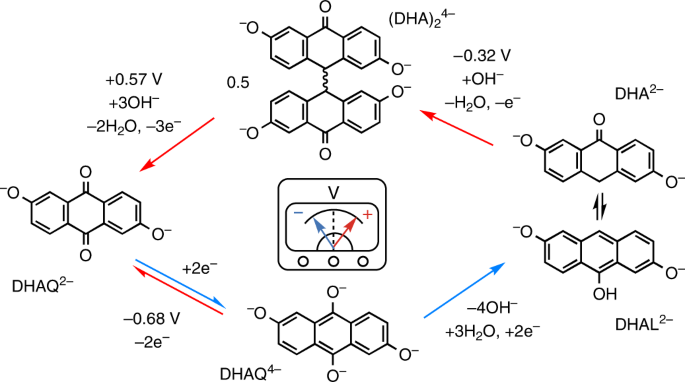商業化の大きな壁を打ち破る新たなアプローチ New approach topples major barrier to commercialization
2022-06-16 ハーバード大学

分解と再分解のサイクル。通常の充放電では、ゾンビ分子はDHAQ2-型(左)とDHAQ4-型(中央下)の間で振動している。分解されるとDHA2-になる(右)。電圧パルスによって、分解された分子(右)は元の形(左)にリセットされる。
Credit: Yan Jing/Harvard SEAS
過去10年間にわたり、炭素、水素、酸素といった天然に豊富に存在する元素からなるアントラキノンという分子を用いて、エネルギーを貯蔵・放出する有機アクアフロー電池を共同開発してきました。
研究の過程で、このアントラキノンは電池を何度使っても時間の経過とともにゆっくりと分解されることを発見しました。
研究チームは以前の研究で、DHAQと名付けられたこの分子を空気に触れさせることで、その寿命を延ばすことができることを発見している。
研究チームは、電池のプラスとマイナスの端子間の電圧差がゼロになるように放電する、いわゆる深放電を行った後、電池の極性を反転させてプラス側を強制的にマイナス、マイナス側をプラスにすると、分解した分子を元の形にリセットできる電圧パルスが発生することを発見した。
ハーバード大学の技術開発局は、このプロジェクトに関連する知的財産を保護し、キノンフロー電池に関する技術およびその他の関連特許を、商業開発を追求する新興企業であるQuinoEnergyにライセンス供与しました。
<関連情報>
- https://www.seas.harvard.edu/news/2022/06/research-extends-lifetime-molecules-organic-flow-batteries-practical-values
- https://www.nature.com/articles/s41557-022-00967-4
水系有機フロー電池における分解した酸化還元活性種のその場電気化学的再合成 In situ electrochemical recomposition of decomposed redox-active species in aqueous organic flow batteries
Yan Jing,Evan Wenbo Zhao,Marc-Antoni Goulet,Meisam Bahari,Eric M. Fell,Shijian Jin,Ali Davoodi,Erlendur Jónsson,Min Wu,Clare P. Grey,Roy G. Gordon & Michael J. Aziz
Nature Chemistry Published:16 June 2022
DOI:https://doi.org/10.1038/s41557-022-00967-4
Abstract
Aqueous organic redox flow batteries offer a safe and potentially inexpensive solution to the problem of storing massive amounts of electricity produced from intermittent renewables. However, molecular decomposition represents a major barrier to commercialization—and although structural modifications can improve stability, it comes at the expense of synthetic cost and molecular weight. Now, utilizing 2,6-dihydroxy-anthraquinone (DHAQ) without further structural modification, we demonstrate that the regeneration of the original molecule after decomposition represents a viable route to achieve low-cost, long-lifetime aqueous organic redox flow batteries. We used in situ (online) NMR and electron paramagnetic resonance, and complementary electrochemical analyses to show that the decomposition compound 2,6-dihydroxy-anthrone (DHA) and its tautomer, 2,6-dihydroxy-anthranol (DHAL) can be recomposed to DHAQ electrochemically through two steps: oxidation of DHA(L)2− to the dimer (DHA)24− by one-electron transfer followed by oxidation of (DHA)24− to DHAQ2− by three-electron transfer per DHAQ molecule. This electrochemical regeneration process also rejuvenates the positive electrolyte—rebalancing the states of charge of both electrolytes without introducing extra ions.



